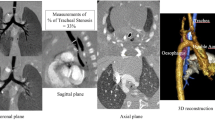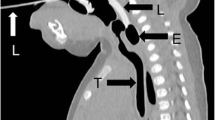Abstract
In their daily forensic casework, the authors experienced discrepancies of tracheobronchial content findings between postmortem computed tomography (PMCT) and autopsy to an extent previously unnoticed in the literature. The goal of this study was to evaluate such discrepancies in routine forensic cases. A total of 327 cases that underwent PMCT prior to routine forensic autopsy were retrospectively evaluated for tracheal and bronchial contents according to PMCT and autopsy findings. Hounsfield unit (HU) values of tracheobronchial contents, causes of death, and presence of pulmonary edema were assessed in mismatching and matching cases. Comparing contents in PMCT and autopsy in each of the separately evaluated compartments of the respiratory tract low positive predictive values were assessed (trachea, 38.2 %; main bronchi, 40 %; peripheral bronchi, 69.1 %) indicating high discrepancy rates. The majority of tracheobronchial contents were viscous stomach contents in matching cases and low radiodensity materials (i.e., HU < 30) in mismatching cases. The majority of causes of death were cardiac related in the matching cases and skull/brain trauma in the mismatching cases. In mismatching cases, frequency of pulmonary edema was significantly higher than in matching cases. It can be concluded that discrepancies in tracheobronchial contents observed between PMCT and routine forensic autopsy occur in a considerable number of cases. Discrepancies may be explained by the runoff of contents via nose and mouth during external examination and the flow back of tracheal and main bronchial contents into the lungs caused by upright movement of the respiratory tract at autopsy.





Similar content being viewed by others
Abbreviations
- CI:
-
Confidence interval
- FN:
-
False negative
- FP:
-
False positive
- HU:
-
Hounsfield unit
- NPV:
-
Negative predictive value
- PMCT:
-
Postmortem computed tomography
- PMI:
-
Postmortem interval
- PPV:
-
Positive predictive value
- ROI:
-
Region of interest
- TN:
-
True negative
- TP:
-
True positive
References
Thali MJ, Yen K, Schweitzer W, Vock P, Boesch C, Ozdoba C, Schroth G, Ith M, Sonnenschein M, Doernhoefer T, Scheurer E, Plattner T, Dirnhofer R (2003) Virtopsy, a new imaging horizon in forensic pathology: virtual autopsy by postmortem multislice computed tomography (MSCT) and magnetic resonance imaging (MRI)—a feasibility study. J Forensic Sci 48(2):386–403
Knight B (1996) Forensic pathology. Arnold, London
Brogdon BG (2010) Brogdon’s forensic radiology, 2nd edn. CRC Press, Boca Raton
Dirnhofer R, Jackowski C, Vock P, Potter K, Thali MJ (2006) VIRTOPSY: minimally invasive, imaging-guided virtual autopsy. Radiographics 26(5):1305–1033
Zech WD, Jackowski C, Buetikofer Y, Kara L (2014) Characterization and differentiation of body fluids, putrefaction fluid, and blood using Hounsfield unit in postmortem CT. Int J Legal Med 128(5):795–802
Flach PM, Gascho D, Schweitzer W, Ruder TD, Berger N, Ross SG, Thali MJ, Ampanozi G (2014) Imaging in forensic radiology: an illustrated guide for postmortem computed tomography technique and protocols. Forensic Sci Med Pathol 10(4):583–606
Persson A, Jackowski C, Engström E, Zachrisson H (2008) Advances of dual source, dual-energy imaging in postmortem CT. Eur J Radiol 68(3):446–455
Grabherr S, Grimm J, Dominguez A, Vanhaebost J, Mangin P (2014) Advances in post-mortem CT-angiography. Br J Radiol 87(1036):20130488
Gitto L, Serinelli S, Busardò FP, Panebianco V, Bolino G, Maiese A (2014) Can post-mortem computed tomography be considered an alternative for autopsy in deaths due to hemopericardium? J Geriatr Cardiol 11(4):363–367
Filograna L, Tartaglione T, Vetrugno G, Guerra C, Fileni A, Bonomo L (2015) Freshwater drowning in a child: A case study demonstrating the role of post-mortem computed tomography. Med Sci Law pii: 0025802414568045. [Epub ahead of print]
Franckenberg S, Schulze C, Bolliger SA, Gascho D, Thali MJ, Flach PM (2015) Postmortem angiography in computed tomography and magnetic resonance imaging in a case of fatal hemorrhage due to an arterio-venous malformation in the brain. Leg Med (Tokyo) 17(3):180–183
Weustink AC, Hunink MG, van Dijke CF, Renken NS, Krestin GP, Oosterhuis JW (2009) Minimally invasive autopsy: an alternative to conventional autopsy? Radiology 250(3):897–904
Garrie DB, J. David Morrissy (2014) Digital Forensic Evidence in the Courtroom: Understanding Content and Quality, 12 Nw J Tech & Intell Prop 121 http://scholarlycommons.law.northwestern.edu/njtip/vol12/iss2/5
Schulze C, Hoppe H, Schweitzer W, Schwendener N, Grabherr S, Jackowski C (2013) Rib fractures at postmortem computed tomography (PMCT) validated against the autopsy. Forensic Sci Int 233(1-3):90–98
Roberts IS, Benamore RE, Benbow EW, Lee SH, Harris JN, Jackson A, Mallett S, Patankar T, Peebles C, Roobottom C, Traill ZC (2012) Post-mortem imaging as an alternative to autopsy in the diagnosis of adult deaths: a validation study. Lancet 379(9811):136–142
Filograna L, Bolliger SA, Ross SG, Ruder T, Thali MJ (2011) Pros and cons of post-mortem CT imaging on aspiration diagnosis. Leg Med (Tokyo) 13(1):16–21
Recommendation no. R (99) 3 of the Committee of Ministers to member states on the harmonization of medico-legal autopsy rules. (2000) Forensic Sci Int 111(1-3):5-58
Rutty G (2005) Essentials of autopsy practice, current methods and modern trends, 3rd edn. Springer, London
Burton JL, Rutty G (2010) The hospital autopsy, a manual of fundamental autopsy practice, 3rd edn. Hodder Arnold, London
Sivridis E, Pavlidis P, Stamos C, Giatromanolaki A (2010) Sudden death after myocardial infarction in a high-school athlete. J Forensic Sci 55(5):1378–1379
Abu Saleh WK, Aljabbari O, Ramlawi B, Ramchandani M (2015) Case report: necrosis of the anterolateral papillary muscle-an unusual mechanical complication of myocardial infarction. Methodist Debakey Cardiovasc J 11(1):48–50
Dixon DL, Griggs KM, De Pasquale CG, Bersten AD (2015) Pulmonary effects of chronic elevation in microvascular pressure differ between hypertension and myocardial infarct induced heart failure. Heart Lung Circ 24(2):158–164
Tarvasmäki T, Harjola VP, Nieminen MS, Siirilä-Waris K, Tolonen J, Tolppanen H, Lassus J; FINN-AKVA Study Group (2014) Acute heart failure with and without concomitant acute coronary syndromes: patient characteristics, management, and survival. J Card Fail 20(10):723–730
D’Souza S (2015) Aneurysmal subarachnoid hemorrhage. J Neurosurg Anesthesiol 27(3):222–240
Busl KM, Bleck TP (2015) Neurogenic pulmonary edema. Crit Care Med 43(8):1710–1715. doi:10.1097/CCM.0000000000001101
Chaari A, Chtara K, Toumi N, Bahloul M, Bouaziz M (2015) Neurogenic pulmonary edema after severe head injury: a transpulmonary thermodilution study. Am J Emerg Med 33(6):858, e1-3
Christe A, Aghayev E, Jackowski C, Thali MJ, Vock P (2008) Drowning—post-mortem imaging findings by computed tomography. Eur Radiol 18(2):283–290
Filograna L, Ross S, Bolliger S, Germerott T, Preiss U, Flach PM, Thali M (2011) Blood aspiration as a vital sign detected by postmortem computed tomography imaging. J Forensic Sci 56(3):630–637
Ishida M, Gonoi W, Hagiwara K, Okuma H, Shintani Y, Abe H, Takazawa Y, Ohtomo K, Fukayama M (2014) Fluid in the airway of nontraumatic death on postmortem computed tomography: relationship with pleural effusion and postmortem elapsed time. Am J Forensic Med Pathol 35(2):113–117
Hyodoh H, Shimizu J, Watanabe S, Okazaki S, Mizuo K, Inoue H (2015) Time-related course of pleural space fluid collection and pulmonary aeration on postmortem computed tomography (PMCT). Leg Med (Tokyo) 17(4):221–225
Acknowledgments
We would like to express our gratitude to the team of forensic pathologists and forensic technicians from the Department of Forensic Medicine, Institute of Forensic Medicine, University of Bern, for their support with case handling.
Author information
Authors and Affiliations
Corresponding author
Rights and permissions
About this article
Cite this article
Zech, WD., Jackowski, C., Schwendener, N. et al. Postmortem CT versus forensic autopsy: frequent discrepancies of tracheobronchial content findings. Int J Legal Med 130, 191–198 (2016). https://doi.org/10.1007/s00414-015-1264-5
Received:
Accepted:
Published:
Issue Date:
DOI: https://doi.org/10.1007/s00414-015-1264-5




